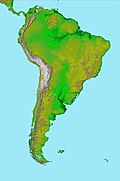Pampean orogeny
This article has multiple issues. Please help improve it or discuss these issues on the talk page. (Learn how and when to remove these messages)
|

The Pampean orogeny was an orogeny active in the Cambrian in the western margin of the ancient landmass of Gondwana. The orogens remains can now be observed in central Argentina, in particular at the Sierras de Córdoba and other parts of the eastern Sierras Pampeanas. The modern relief of Sierras de Córdoba is however related to the much more recent Andean orogeny in the Tertiary.[1] It is uncertain if the orogeny involved at some point a continental collision. The Pampean orogen can be considered part of the larger Terra Australis orogen.[2]
The Pampean orogen contains a belt of igneous rocks including granodiorites, monzogranites, and volcanic rocks, all of them of calc-alkaline chemistry. The igneous rocks of this belt formed at various times in over the period from 555 to 525 million years ago. From 525 million years ago onward another igneous belt of different chemistry developed in the orogen. The rocks of this belt formed in the period from 525 to 515 million years ago.[2]
References
- ^ Rapela, C.W.; Pankhurst, R.J; Casquet, C.; Baldo, E.; Saavedra, J.; Galindo, C.; Fanning, C.M. (1998). "The Pampean Orogeny of the southern proto-Andes: Cambrian continental collision in the Sierras de Córdoba" (PDF). In Pankhurst, R.J; Rapela, C.W. (eds.). The Proto-Andean Margin of Gondwana. Vol. 142. Geological Society, London, Special Publications. pp. 181–217. Retrieved 7 December 2015.
- ^ a b Schwartz, Joshua J.; Gromet, L. Peter; Miró, Roberto (2008). "Timing and Duration of the Calc‐Alkaline Arc of the Pampean Orogeny: Implications for the Late Neoproterozoic to Cambrian Evolution of Western Gondwana". The Journal of Geology. 116 (1): 39–61. doi:10.1086/524122. Retrieved 7 December 2015.

